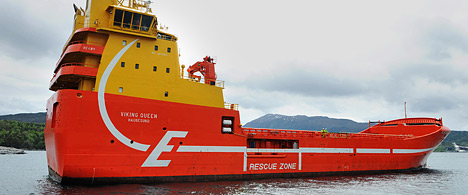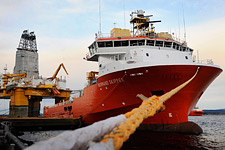
Viking Energy and sister vessel Viking Queen (image) are powered by LNG – as is Stril Pioner. A fourth LNG ship is under construction. (Photo: Harald Pettersen)
At the Ågotnes base in Hordaland, Normand Skipper has taken on board supplies for the North Sea platforms. On deck there is everything from drilling equipment to helicopter fuel.
They complete the round trip at the economy speed of 12 knots, even though they could have done 15 knots. Even a slight reduction in speed results in a major environmental gain.
“On one single trip out to Statfjord, Kvitebjørn and Veslefrikk, CO2 emissions are cut by more than six tonnes. This amounts to 1,900 tonnes CO2 per year, equivalent to the annual emissions from roughly 800 cars,” says Ellen Karoline Norlund, project manager for Green Logistics in Statoil.

Supply ships such as Normand Skipper supply everything – from drilling equipment to toilet paper – to the platforms.
Since 2008 Norlund and her colleagues have been examining the supply chain to make goods freight more environmentally friendly.
Ninety percent of emissions are produced by vessels, therefore the project’s main efforts have been targeted at the 20 supply ships operating for Statoil. This is not just climate friendly, it also makes sound economic sense.
“We are paying for the fuel. The less fuel the vessels use, the more money we save,” says Norlund, adding that they also include emissions from anchor handling vessels and emergency response vessels.
Captain Sigmund Landa stands on the bridge of Normand Skipper. He thinks it is fine to reduce speed, as long as the sailing plan allows for this. A two knot slower speed means the trip to Statfjord takes nine hours instead of eight.
Planning
“We work a lot to improve our route planning, which is necessary in order to make our transport as energy efficient as possible,” says Norlund. The economy speed requirement is new, but several vessels have already reduced their speeds to save fuel and reduce emissions.
“We cooperate closely with shipping companies and set a number of specific environmental requirements for the ships that will be working for us,” she says.
For example, vessels on long-term contracts must have a catalytic converter or similar device for reducing NOX emissions.
“We are also willing to pay more for vessels fuelled by LNG,” says Norlund.
LNG ships
Three out of four supply vessels are now powered by LNG. A fourth is under construction. Swapping diesel for LNG reduces CO2 emissions by 20 per cent and NOX emissions by 90 per cent. Emissions of sulphur and particles are completely eliminated.
Each new ship becomes more environmentally friendly than the ship it replaces.
“We would like to charter more vessels that have a high environmental profile,” says Norlund.